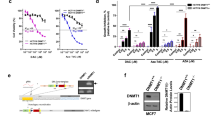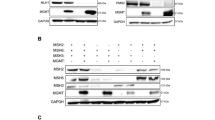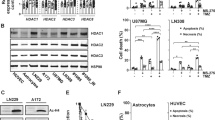Abstract
HCT116 and HCT15 cells that highly express O6-methylguanine-DNA-methyltransferase (MGMT) displayed a transient cell cycle G2/M arrest in response to exposure to 1,3-bis(2-chloroethyl)-1-nitrosourea (BCNU) alone; however, 70–80% of cells were arrested in G2/M after treatment with O6-benzylguanine (BG) and BCNU. Cells accumulated in G2/M showed elevated levels of an inactive form of cyclin B1/p-Cdc2 (Tyr15) complex that was not associated with activation of Chk1/p-Cdc25C and was independent of p53/p21 status. The most prominent feature of cell death was the appearance of enlarged and multinucleated cells that was related to the inhibition of mitotic entry. In contrast, BG-resistant cell lines, HCT116 BBR and HCT15 BBR cells that contain mutations K165E and K165N of MGMT, respectively, displayed a normal cell cycle progression with a slight and transient increase in G2/M arrest at 24 h after treatments with either BCNU alone or BG combined with BCNU. The differences in the ability to progress toward G2/M after treatment with BG and BCNU between cells expressing wild-type MGMT and mutated MGMT were confirmed in CHO cells transfected with human wild type and K165E mutant MGMT cDNA, respectively. Thus, our findings suggest that BG-inactivated MGMT may be linked to cell signaling events, forcing cells into a permanent G2/M arrest in response to the DNA damages induced by BCNU.
This is a preview of subscription content, access via your institution
Access options
Subscribe to this journal
Receive 50 print issues and online access
$259.00 per year
only $5.18 per issue
Buy this article
- Purchase on Springer Link
- Instant access to full article PDF
Prices may be subject to local taxes which are calculated during checkout










Similar content being viewed by others
References
Aguda BD . (1999). Proc. Natl. Acad. Sci. USA, 96, 11352–11357.
Andreassen PR, Lacroix FB, Lohez OD and Margolis RL . (2001). Cancer Res., 61, 7660–7668.
Bunz F, Dutriaux A, Lengauer C, Waldman T, Zhou S, Brown JP, Sedivy JM, Kinzler KW and Vogelstein B . (1998). Science, 282, 1497–1501.
Campisi J . (2001). Trends Cell Biol., 11, S27–S31.
Chang BD, Broude EV, Dokmanovic M, Zhu H, Ruth A, Xuan Y, Kandel ES, Lausch E, Christov K and Roninson IB . (1999a). Cancer Res., 59, 3761–3767.
Chang BD, Swift ME, Shen M, Fang J, Broude EV and Roninson IB . (2002). Proc. Natl. Acad. Sci., 99, 389–394.
Chang BD, Xuan Y, Broude EV, Zhu H, Schott B, Fang J and Roninson IB . (1999b). Oncogene, 18, 4808–4818.
Cox LS and Lane DP . (1995). Bioessays, 17, 501–508.
Craig KL and Tyers M . (1999). Prog. Biophys. Mol. Biol., 72, 299–328.
Deming PB, Cistulli CA, Zhao H, Graves PR, Piwnica-Worms H, Paules RS, Downes CS and Kaufmann WK . (2001). Proc. Natl. Acad. Sci. USA, 98, 12044–12049.
Funari B, Rhind N and Russell P . (1997). Science, 277, 1495–1497.
Gerson SL, Zborowska E, Norton K, Gordon NH and Willson JK . (1993). Biochem. Pharmacol., 45, 483–491.
Gibson NW, Mattes WB and Hartley JA . (1985). Pharmacol. Ther., 31, 153–163.
Hartwell LH and Weinert TA . (1989). Science, 246, 629–634.
Hirose Y, Berger MS and Pieper RO . (2001). Cancer Res., 61, 5843–5849.
Hochstrasser M . (1998). Genes Dev., 12, 901–907.
Hoffman I, Clarke PR, Marcote MJ, Karsenti E and Draetta G . (1993). EMBO J., 12, 53–63.
Kaufmann WK and Kies PE . (1998). Mutation Res., 400, 153–167.
Kaufmann WK and Paules RS . (1996). FASEB J., 10, 238–247.
Koniaras K, Cuddihy AR, Christopoulos H, Hogg A and O'Connell MJ . (2001). Oncogene, 20, 7453–7463.
Kuerbitz SJ, Pluntett BS, Walsh WV and Kastan MB . (1992). Proc. Natl. Acad. Sci. USA, 89, 7491–7495.
Liu L, Markowitz S and Gerson SL . (1996). Cancer Res., 56, 5375–5379.
Liu L, Schwartz S, Davis BM and Gerson SL . (2002). Cancer Res., 62, 3070–3076.
Liu Q, Guntuku S, Cui XS, Matsuoka S, Cortez D, Tamai K, Luo G, Carattini-Rivera S, DeMayo F, Bradley A, Donehower LA and Elledge SJ . (2000). Genes Dev., 14, 1448–1459.
Lock RB . (1992). Cancer Res., 52, 1817–1822.
Monte M, Benetti R, Buscemi G, Sandy P, Del Sal G and Schneider C . (2003). J. Biol. Chem., 278, 30356–30364.
Mullapudi SRS, Ali-Osman F, Shou J and Srivenugopal KS . (2000). Biochem. J., 351, 393–402.
O'Connell MJ, Raleigh JM, Verkade HM and Nurse P . (1997). EMBO J., 16, 545–554.
Park JI, Jeong JS, Han JY, Kim DI, Gao YH, Park SC, Rodger GP and Kim IH . (2000). J. Cancer Res. Clin. Oncol., 126, 455–460.
Pegg AE . (1990). Cancer Res., 50, 6119–6129.
Peng C-Y, Graves RS, Thoma Z, Wu AS, Shaw H and Piwnica-Worms H . (1997). Science, 277, 1501–1505.
Poon RY, Jiang W, Toyoshima H and Hunter T . (1996). J. Biol. Chem., 271, 13283–13291.
Roninson IB . (2003). Cancer Res., 63, 2705–2715.
Sanchez Y, Wong C, Thoma RS, Richman R, Wu Z, Piwnica-Worms H and Elledge SJ . (1997). Science, 277, 1497–1501.
Shah MA and Schwartz GK . (2001). Clin. Cancer Res., 7, 2168–2181.
Smits VA, Klompmaker R, Vallenius T, Rijksen G, Makela TP and Medema RH . (2000). J. Biol. Chem., 275, 30638–30643.
Srivenugopal KS, Mullapudi SRS, Shou J, Hazra TK and Ali-Osman F . (2000). Cancer Res., 60, 282–287.
Srivenugopal KS, Yuan X-H, Friedman HS and Ali-Osman F . (1996). Biochemistry, 35, 1328–1334.
Stamato TD and Denko N . (1990). Radiat. Res., 121, 196–205.
Taylor WR and Stark GR . (2001). Oncogene, 20, 1803–1815.
Vlach J, Hennecke S and Amati B . (1997). EMBO J., 16, 5334–5344.
Wang X, Wong SC, Pan J, Tsao SW, Fung KH, Kwong DL, Sham JS and Nicholls JM . (1998). Cancer Res., 58, 5019–5022.
Wei Y, Yu L, Bowen J, Gorovsky MA and Allis CD . (1999). Cell, 97, 99–109.
Xiong Y, Gannon GJ, Xhang H, Casso D, Kobayashi R and Beach D . (1993). Nature, 366, 701–704.
Acknowledgements
We thank Dr Stanton L Gerson for providing Vaco 8/MGMT cells and for helpful discussions. This work was supported by Public Health Service Grants RO1CA82292.
Author information
Authors and Affiliations
Corresponding author
Rights and permissions
About this article
Cite this article
Yan, L., Donze, J. & Liu, L. Inactivated MGMT by O6-Benzylguanine is associated with prolonged G2/M arrest in cancer cells treated with BCNU. Oncogene 24, 2175–2183 (2005). https://doi.org/10.1038/sj.onc.1208250
Received:
Revised:
Accepted:
Published:
Issue Date:
DOI: https://doi.org/10.1038/sj.onc.1208250
Keywords
This article is cited by
-
Rad9a is involved in chromatin decondensation and post-zygotic embryo development in mice
Cell Death & Differentiation (2019)
-
1,2:5,6-dianhydrogalactitol inhibits human glioma cell growth in vivo and in vitro by arresting the cell cycle at G2/M phase
Acta Pharmacologica Sinica (2017)
-
Endoplasmic reticulum protein 29 (ERp29) confers radioresistance through the DNA repair gene, O6-methylguanine DNA-methyltransferase, in breast cancer cells
Scientific Reports (2015)
-
O6-Methylguanine-DNA methyltransferase (MGMT) gene expression is associated with ultraviolet B (UVB)-induced cell growth inhibition and recovery
Genes & Genomics (2015)
-
Effect of gestational protein deficiency and excess on hepatic expression of genes related to cell cycle and proliferation in offspring from late gestation to finishing phase in pig
Molecular Biology Reports (2012)



